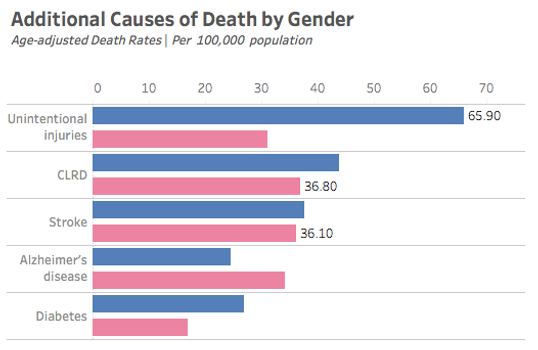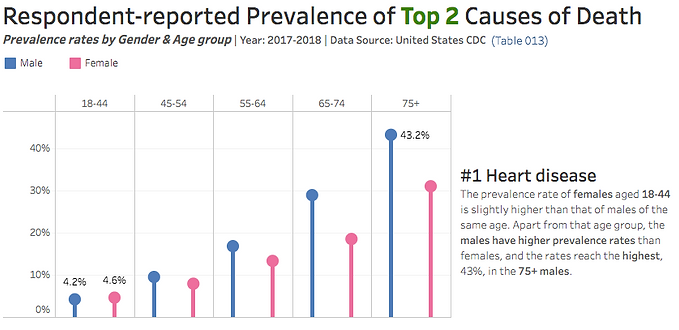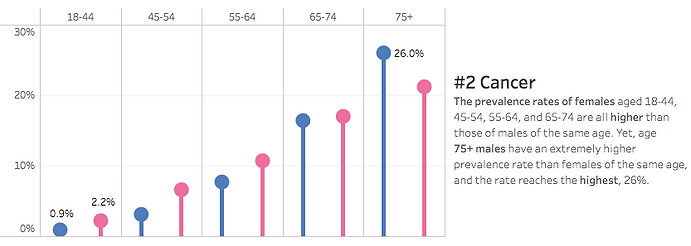Risk Management - Public Health
Introduction
During my last quarter of graduate school, I took a Risk Management Analytics course taught by professor Michael Cavallo. This was an extra credit project from that course. Instead of using business-oriented data, this project aimed to analyze public-oriented data. I downloaded two datasets from the Centers for Disease Control and Prevention (CDC) and created some graphs to explore stories behind statistics. To be more specific, the first dataset is related to age-adjusted death rates for selected causes of death. The second dataset is related to the average annual prevalence of certain causes of death among adults aged 18 and over in the United States. Note that the second dataset was based on household interview data.
Dataset 1
From Figure 1 below, we can tell that overall, the death rates from heart disease and cancer are much higher than the death rates from other factors.

Figure 1
To give a targeted risk management plan for the Top 2 causes of death, I further created Figure 2 below, which is by gender. From Figure 2, we can see that for males, the death rate from heart disease is much higher than the death rate from cancer. Yet, for females, the death rate from heart disease is even a little lower than the death rate from cancer. Thus, as I found that heart disease is the leading cause of death for men, I identified it as the first risk.

Figure 2
#1 Risk: Men have a high death rate from heart disease
In terms of the solution to this risk, for example, the government can educate people, especially men, to have some background knowledge regarding heart disease. Also, the government can teach people how to prevent it or put some signs in the public to remind people and evoke their awareness.
To give risk management plans for other causes of death, I created Figure 3. From Figure 3 below, we can tell that there are gender differences. To be more specific, for males, the death rate from unintentional injuries is higher than the death rate from other factors, and for females, CLRD (Chronic lower respiratory diseases) is the third-leading cause of death, followed by stroke. Thus, I identified them as second and third risks.

Figure 3
#2 Risk: Men have a high death rate from unintentional injuries
According to Johns Hopkins Medicine, the top three causes of fatal unintentional injuries include motor vehicle crashes, poisoning, and falls. Thus, to mitigate this risk, the government can further investigate the causes by age. For example, the government can research specifically causes of motor vehicle crashes for males in middle age. On the other hand, in terms of poisoning, according to Women's Health Research Institute, the poisoning includes the use of drugs or chemicals for recreational purposes in excessive amounts. Thus, the government can promote and supervise drug education programs in schools, to educate students as early as possible.
#3 Risk: Women have a high death rate from CLRD
Chronic lower respiratory disease is a group of conditions that affect the lungs. According to the West Virginia Department of Health & Human Resources, since women have smaller airways relative to lung size than men, lung damage occurs more quickly and more severely in females exposed to the same contaminants as males. Thus, the government can focus the anti-smoking campaign on women, since cigarette smoking is the major cause of CLRD.
Dataset 2
To understand more about the Top 2 causes of death, I used the second dataset to create Figure 4. From the chart below, we can tell that overall, heart disease is more prevalent among men than among women. Also, the prevalence rate increases as age increases. Thus, I identified it as the fourth risk.

Figure 4
#4 Risk: Heart disease is more prevalent among men than among women
Apart from educating people, the government can also cooperate with employers to ask them to regularly offer biometric screenings for employees, since typical biometric screenings will look at heart disease risk factors. Thus, employees can take early measures and prevent heart disease.
Lastly, from Figure 5 below, we can see that until age 75+, cancer is more prevalent among women than among men. Thus, I identified it as the fifth risk.

Figure 5
#5 Risk: Cancer is more prevalent among women than among men
American Cancer Society stated that breast cancer is the most common cancer in American women (2021). Thus, apart from offering traditional biometric screenings, employers can also consider providing female employees with allowances for breast cancer screening.
Conclusion
By using public data, I investigated the death rates for different causes of death by gender, and examined the prevalence of heart disease and cancer by gender and age. Then, after identifying five risks, I proposed solutions to mitigate them.
Thank you for reading 😊
See Tableau: Public Health Data Analysis
References
[1] American Cancer Society. (2021, May 7). How Common Is Breast Cancer? Retrieved from https://www.cancer.org/cancer/breast-cancer/about/how-common-is-breast-cancer.html
[2] Johns Hopkins Medicine. (n.d.). Unintentional Injury Statistics. Retrieved from
https://www.hopkinsmedicine.org/health/wellness-and-prevention/unintentional-injury-statistics
[3] West Virginia Department of Health & Human Resources. (2016, September 12). I. Chronic Lower Respiratory Disease: A National Burden. Retrieved from www.wvdhhr.org/bph/hsc/pubs/other/clrd/national.htm
[4] Women's Health Research Institute. (n.d.). UNINTENTIONAL POISONING DEATHS OFTEN DUE TO MISUSE OF PRESCRIPTION DRUGS. Retrieved from https://womenshealth.obgyn.msu.edu/blog/unintentional-poisoning-deaths-often-due-misuse-prescription-drugs